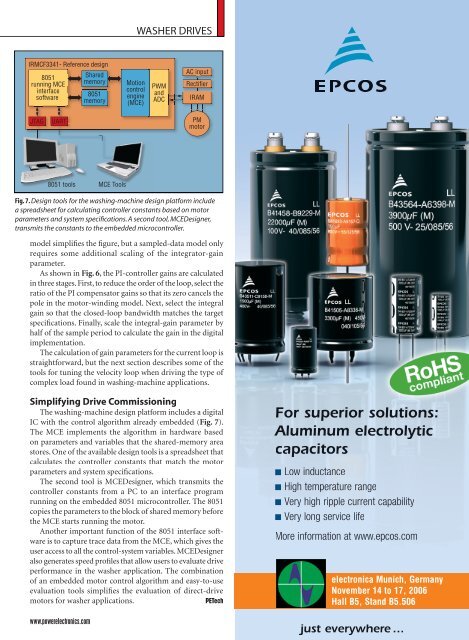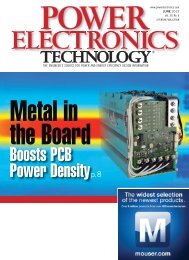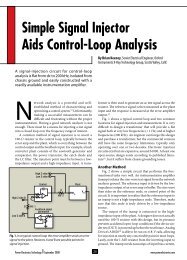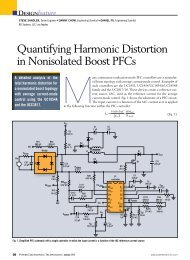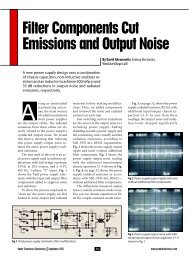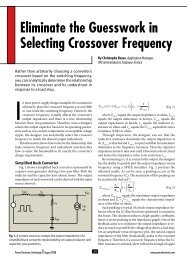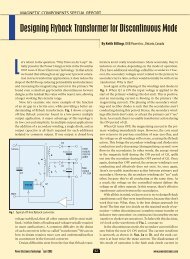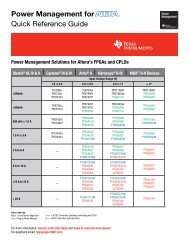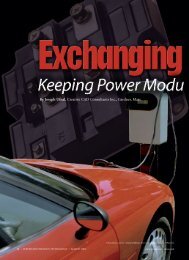phase - Power Electronics
phase - Power Electronics
phase - Power Electronics
You also want an ePaper? Increase the reach of your titles
YUMPU automatically turns print PDFs into web optimized ePapers that Google loves.
IRMCF3341- Reference design<br />
8051<br />
running MCE<br />
interface<br />
software<br />
Shared<br />
memory<br />
8051<br />
memory<br />
Motion<br />
control<br />
engine<br />
(MCE)<br />
PWM<br />
and<br />
ADC<br />
AC input<br />
Rectifier<br />
IRAM<br />
JTAG UART<br />
8051 tools<br />
MCE Tools<br />
WASHER DRIVES<br />
PM<br />
motor<br />
Fig. 7. Design tools for the washing-machine design platform include<br />
a spreadsheet for calculating controller constants based on motor<br />
parameters and system specifi cations. A second tool, MCEDesigner,<br />
transmits the constants to the embedded microcontroller.<br />
model simplifi es the fi gure, but a sampled-data model only<br />
requires some additional scaling of the integrator-gain<br />
parameter.<br />
As shown in Fig. 6, the PI-controller gains are calculated<br />
in three stages. First, to reduce the order of the loop, select the<br />
ratio of the PI compensator gains so that its zero cancels the<br />
pole in the motor-winding model. Next, select the integral<br />
gain so that the closed-loop bandwidth matches the target<br />
specifi cations. Finally, scale the integral-gain parameter by<br />
half of the sample period to calculate the gain in the digital<br />
implementation.<br />
The calculation of gain parameters for the current loop is<br />
straightforward, but the next section describes some of the<br />
tools for tuning the velocity loop when driving the type of<br />
complex load found in washing-machine applications.<br />
Simplifying Drive Commissioning<br />
The washing-machine design platform includes a digital<br />
IC with the control algorithm already embedded (Fig. 7).<br />
The MCE implements the algorithm in hardware based<br />
on parameters and variables that the shared-memory area<br />
stores. One of the available design tools is a spreadsheet that<br />
calculates the controller constants that match the motor<br />
parameters and system specifi cations.<br />
The second tool is MCEDesigner, which transmits the<br />
controller constants from a PC to an interface program<br />
running on the embedded 8051 microcontroller. The 8051<br />
copies the parameters to the block of shared memory before<br />
the MCE starts running the motor.<br />
Another important function of the 8051 interface software<br />
is to capture trace data from the MCE, which gives the<br />
user access to all the control-system variables. MCEDesigner<br />
also generates speed profi les that allow users to evaluate drive<br />
performance in the washer application. The combination<br />
of an embedded motor control algorithm and easy-to-use<br />
evaluation tools simplifi es the evaluation of direct-drive<br />
motors for washer applications. PETech<br />
For superior solutions:<br />
Aluminum electrolytic<br />
capacitors<br />
Low inductance<br />
High temperature range<br />
Very high ripple current capability<br />
Very long service life<br />
More information at www.epcos.com<br />
electronica Munich, Germany<br />
November 14 to 17, 2006<br />
Hall B5, Stand B5.506<br />
www.powerelectronics.com <strong>Power</strong> <strong>Electronics</strong> Technology<br />
just everywhere …


